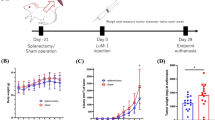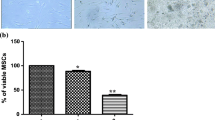Abstract
The effects of NAMI-A, [H2im][trans-RuCl4(dmso-S)(Him)], a new metal-based agent for treating tumor metastases, have been investigated in vitro on splenocytes, ConA- or LPS-activated T and B lymphoblasts, and thymocytes. Splenocytes and thymocytes exposed for 1 h to 0.01–0.1-mM NAMI-A do not change their mitochondrial functionality, cell cycle distribution, protein synthesis, and CD44 expression in comparison to untreated control samples. Instead, mitochondrial functionality increased 24 h after treatment in a fraction of splenocytes. The same treatment reduced mitochondrial functionality and S phase of the cell cycle in T and B blasts (already after 1 h treatment) and reduced CD44 expression on B blasts, 24 h after treatment. On cocultures of splenocytes and metastatic cells (metGM) (1:1), NAMI-A induces a selective depolarization of mitochondrial membrane potential of metGM cells, while it stimulates splenocytes (mainly lymphocytes), as shown by the increase of the S phase, nitric oxide production, and adhesion onto metastatic cells. This, in turn, reduces the number of metastatic cells and results in the increased ratio between splenocytes and metGM in favor of diploid cells (doubling from one to two). Rosetting of leukocytes onto metastatic cells correlates with induction of CD54 expression on tumor cells after NAMI-A in vivo treatment, which in turn, might contribute to metastasis recognition by cytotoxic lymphocytes. The overall antimetastatic activity displayed by NAMI-A might therefore be the result of complex interactions with tumor cells, on which it displays selective antitumor activity, and with host immune cells through which it promotes activation of host immune defenses involved in tumor suppression.





Similar content being viewed by others
References
Applegate KG, Balch CM, Pellis NR (1990) In vitro migration of lymphocytes through collagen matrix: arrested locomotion in tumor-infiltrating lymphocytes. Cancer Res 22:7153
Beltran B, Quintero M, Garcia-Zaragoza E, O’Connor E, Esplugues JV, Moncada S (2002) Inhibition of mitochondrial respiration by endogenous nitric oxide: a critical step in Fas signaling. PNAS 99:8892
Bourguignon LYW (2001) CD44-mediated oncogenic signalling and cytoskeleton activation during mammary tumor progression. J Mammary Gland Biol Neopl 6:287
Bourguignon LYW, Zhu H, Shao L, Chen YW (2001) CD44 interaction with c-Src kinase promotes cortactin-mediated cytoskeleton function and hyaluronic acid (HA)-dependent ovarian tumor cell migration. J Biol Chem 276:7327
Cocchietto M, Sava G (2000) Blood concentration and toxicity of the antimetastasis agent NAMI-A following repeated intravenous treatment in mice. Pharmacol Toxicol 87:193
Cossarizza A, Baccarani Contri M, Kalashnikova G, Francheschi C (1993) A new method for cytofluorimetric analysis of mitochondrial membrane potential using J-aggregate forming lipohphilic cation 5, 5′,6, 6′-tetrachloro-1, 1′,3,3′- tetraethylbenzimidazol-carbocyanineiodide (JC-1). Biochem Biophys Res Commun 197:40
Cossarizza A, Ceccarelli D, Masini A (1996) Functional heterogeneity of an isolated mitochondrial population revealed by cytofluorimetric analysis at the single organelle level. Exp Cell Res 222:84
DeGrendele HC, Estess P, Siegelman MH (1997) Requirement for CD44 in activated T cell extravasation into an inflammatory site. Science 278:672
DHHS (1985) Guide for the care and use of laboratory animals. Department of Health and Human Services, National Institutes of Health, Bethesda, MD, p 23
Foss FM (2002) Immunologic mechanisms of antitumor activity. Semin Oncol 29:5
Goldberg EP, Hasdba AR, Almond BA, Marotta JS (2002) Intratumoral cancer chemotherapy and immunotherapy: opportunities for nonsystemic preperative drug delivery. J Pharm Pharmacol 54:159
Haynes BF, Telen MJ, Hale LP, Denning SM (1989) CD44—a molecule involved in leukocyte adherence and T-cell activation. Immunol Today 10:423
Hammond D, Nagarkatti PS, Gote L, Seth A, Hassuneh M, Nagarkatti M (1993) Double-negative T cells from MRL-lpr/lpr mice mediate cytolytic activity when triggered through adhesion molecules and constitutively express perforin gene. J Exp Med 178:2225
Liotta LA, Kohn EC (2001) The microenvironment of the tumor-host interface. Nature 411:375
Mackall CL (1999) T-cell immunodeficiency following cytotoxic antineoplastic therapy: a review. Oncologist 4:370
Magnarin M, Bergamo A, Carotenuto ME, Zorzet S, Sava G (2000) Increase of tumor infiltrating lymphocytes in mice treated with antimetastatic doses of NAMI-A. Anticancer Res 20:2939
Marlin SD, Springer TA (1987) Purified intercellular adhesion molecule (ICAM-1) is a ligand for lymphocyte function-associated antigen-1 (LFA-1). Cell 51:813
Noble PW, Lake LR, Henson PM, Riches DW (1993) Hyaluronate activation of CD44 induces insulin like growth factor 1 expression by a tumor necrosis factor-alpha-dependent mechanism in murine macrophages. J Clin Invest 91:2368
Novak AK, Bruce W, Robinson S, Lake RA (2002) Gemcitabine exerts a selective effect on the humoral immune response implications for combination chemo-immunotherapy. Cancer Res 62:2353
Pacor S, Vadori M, Vita F, Bacac M, Soranzo MR, Zabucchi G, Sava G (2001) Isolation of a murine metastatic cell line and preliminary test of sensitivity to the anti-metastasis agent NAMI-A. Anticancer Res 21:2523
Pacor S, Cocchietto M, Zorzet S, Bacac M, Vadori M, Castellarin A, Turrin C, Sava G (2004) Intra-tumoral NAMI-A treatment triggers metastasis reduction, which correlates to CD44 regulation and TIL recruitment. J PET (in press)
Pintus G, Tadolini B, Posadino AM, Sanna B, Debidda M, Bennardini F, Sava G, Ventura C (2002) Inhibition of the MEK/ERK signaling pathway by the novel antimetastatic agent NAMI-A down-regulates c-myc gene expression and endothelial cell proliferation. Eur J Biochem 269:5861
Poliak-Blazi M, Boranic M, Marzan B, Radacic M (1986) A transplantable aplastic mammary carcinoma of CBA mice. Vet Arh 51:99
Rafi A, Nagarkatti M, Nagarkatti PS (1997) CD44-hyaluronic acid interactions in B lymphocyte cell activation. Blood 89:2901
Reimann T, Buscher D, Hipskind RA, Krautwald S, Lohmann-Matthes ML, Baccarini M (1994) Lipopolysaccharide induces activation of the Raf-1/MAP kinase pathway: a putative role for Raf-1 in the induction of the IL-1 beta and the TNF-alpha genes. J Immunol 153:5740
Sava G, Bergamo A (2000) Ruthenium-based compounds and tumor growth control. Int J Oncol 17:353
Sava G, Capozzi I, Clerici K, Gagliardi R, Alessio E, Mestroni G (1998) Pharmacological control of lung metastases of solid tumors by a novel ruthenium complex. Clin Exp Met 16:371
Sava G, Zorzet S, Turrin C, Vita F, Soranzo M, Zabucchi G, Cocchietto M, Bergamo A, DiGiovine S, Pezzoni G, Sartor L, Garbisa S (2003) Dual action of NAMI-A in inhibition of solid tumor metastasis: selective targeting of metastatic cells and binding to collagen. Clin Cancer Res 9:1898
Sconocchia G, Campagnano L, Adorno D, Iacona A, Cococcetta NY, Boffo V, Amadori S, Casciani CU (2001) CD44 ligation on peripheral blood polymorphonuclear cells induces interleukin-6 production. Blood 97:3621
Stahnke K, Fulda S, Friesen C, Straub G, Debatin KM (2001) Activation of apoptosis pathways in peripheral blood lymphocytes by in vivo chemotherapy. Blood 98:3066
Stamenkovic I (2000) Matrix metalloproteinases in tumor invasion and metastasis. Semin Cancer Biol 10:415
Stuehr DJ, Nathan CF (1989) Nitric oxide. A macrophage product responsible for cytostasis and respiratory inhibition in tumor target cells. J Exp Med 169:1543
Teshigawara K, Okubo Y, Sugie K, Uchida A (1994) The regulation of NK cell activity through LFA-1 and p58. Clin Immunol Immunopathol 26:629
Acknowledgements
This work was supported by MIUR (prot. 2001053898_004, Pharmacological mechanisms of the antimetastatic activity of metal-based drugs). Fondazione Callerio Onlus is kindly acknowledged for the financial support of the Ph.D. fellowship of M. Bacac and for making the flow cytometry facility available.
Author information
Authors and Affiliations
Corresponding author
Rights and permissions
About this article
Cite this article
Bacac, M., Vadori, M., Sava, G. et al. Cocultures of metastatic and host immune cells: selective effects of NAMI-A for tumor cells. Cancer Immunol Immunother 53, 1101–1110 (2004). https://doi.org/10.1007/s00262-004-0566-0
Received:
Accepted:
Published:
Issue Date:
DOI: https://doi.org/10.1007/s00262-004-0566-0




